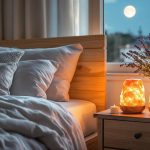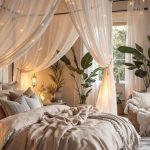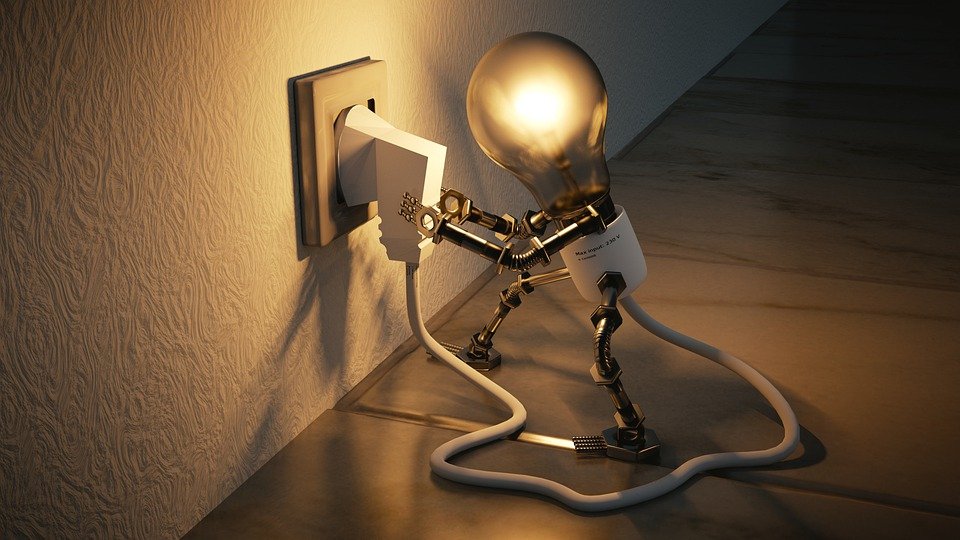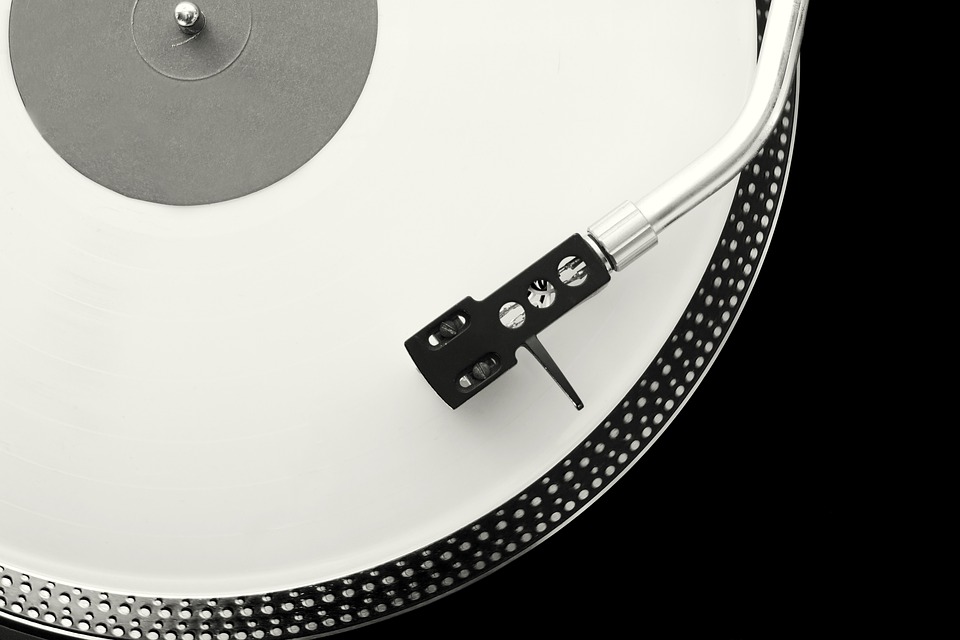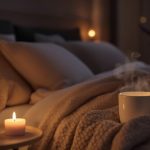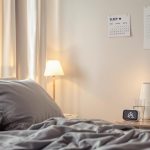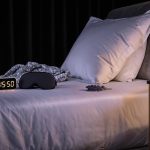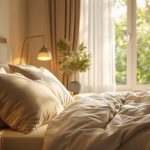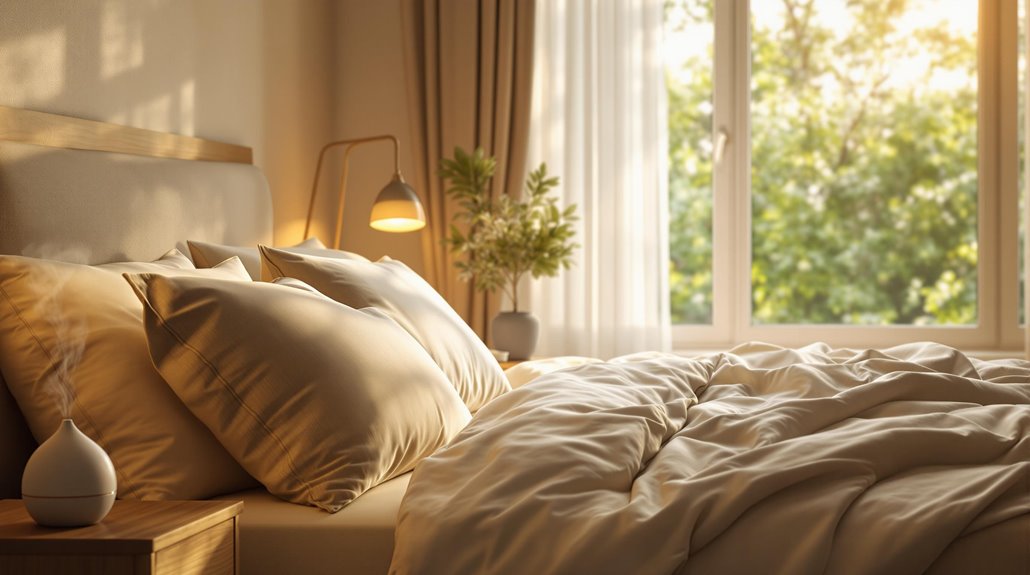
To create the perfect restful sleep environment, start by adjusting your bedroom’s lighting to a soothing glow, ideally between 2400-3000 Kelvin, and avoid harsh blue lights. Maintain an ideal room temperature between 60–68°F (15.6–20°C) for deeper sleep. Reduce noise with earplugs or a white noise machine and invest in soundproof accessories like thick curtains. Choose a medium-firm mattress for balanced support and comfort. Keep electronics out of the bedroom to minimize distractions, and incorporate relaxing scents like lavender. By refining these elements, you’ll find improved sleep quality is within reach, and there’s even more you can explore.
Optimize Bedroom Lighting
Creating the right bedroom lighting transforms your space into a restful haven. By harnessing ambient light that’s soft and inviting, you can enhance your sleep hygiene and liberate yourself from restless nights.
Opt for lighting fixtures that promote warm hues, creating a sanctuary that echoes tranquility. Remember, it’s not just about the type of light, but also color temperature. Choose light bulbs around 2400-3000 Kelvin for a soothing amber hue that aligns with your circadian rhythm. Consider incorporating mindfulness practices into your evening routine to further enhance relaxation, allowing your mind and body to prepare for restful sleep.
Strategic light placement is key. Avoid bright overhead lights and instead use dimmable lamps for flexibility. These adjustments are vital because bright overhead lights can disrupt your melatonin production, which is crucial for sleep.
Whether you’re dimming down with a table lamp or accentuating with a pendant light, aim for a gentle glow that reduces glare and lulls you into relaxation.
Consider fixtures like linen-shaded lamps that envelop your space in a coc.
Regulate Temperature
Creating the Optimal Sleep Environment:
To cultivate a restful sleep environment, one essential component is regulating the room temperature. By mastering temperature control strategies, you set yourself free from restless nights and groggy mornings.
Ideal temperatures range from 60–68°F (15.6–20°C) for most adults, a sweet spot that promotes natural thermoregulation and minimizes night sweats. Infants and older adults might need slight adjustments, but these numbers are an excellent starting point for everyone. Cooler environments also promote deeper sleep stages, including REM, which is crucial for memory processing and emotional regulation. Exposure to small amounts of bright light at night can disrupt these crucial processes by halting melatonin synthesis, so it is recommended to create a dark environment conducive to sleep.
Seasonal adjustments play a significant role in achieving ideal sleep conditions. Aim for 16–18°C in winter and 18–20°C in the summer, balancing comfort and energy efficiency.
As the seasons change, altering your bedding accordingly—lightweight fabrics during warmer months and thicker materials in the cold—helps maintain comfort without the need for drastic thermostat changes.
Control Noise Levels
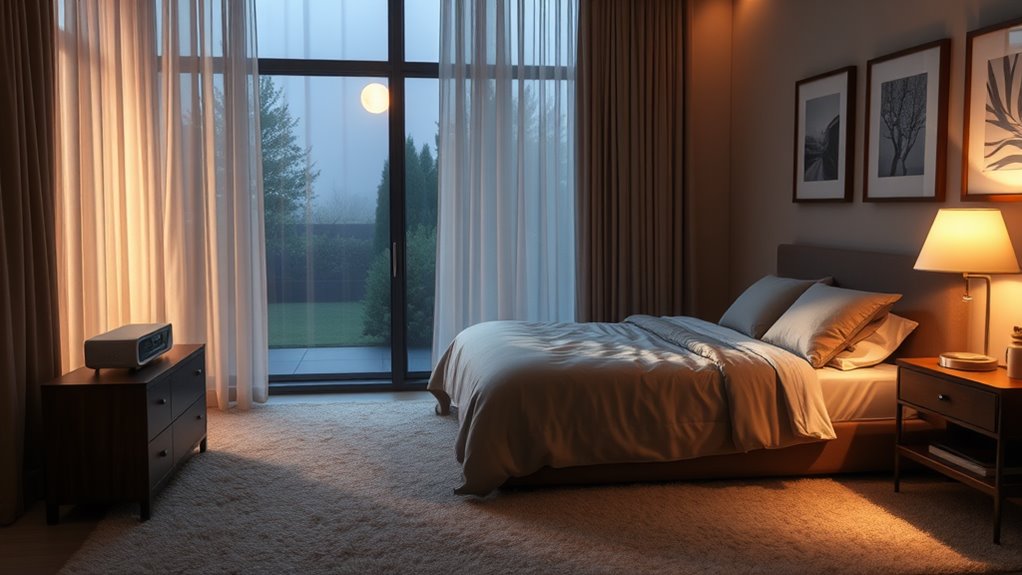
Shutting out disruptive sounds is essential for cultivating a peaceful sleep environment. Embrace the freedom from noise by exploring effective soundproof techniques and noise reduction strategies. Consider foam earplugs for a simple yet impactful solution; their high noise reduction rating can greatly decrease noise exposure. Noise-canceling headphones or earbuds are another excellent option, designed to drown out specific environmental sounds.
Integrate white noise into your sanctuary for blissful sleep. White noise machines and fans can provide consistent background sound, effectively masking sudden disturbances. Experiment with different varieties like pink or brown noise to find what works best for you. Regular exercise promotes better sleep patterns, reduces insomnia symptoms, and helps regulate circadian rhythms, which can enhance your overall sleep quality.
| Method | Purpose | Additional Notes |
|---|---|---|
| Foam Earplugs | Reduce noise exposure | High NRR earplugs should be replaced regularly to maintain hygiene. |
| White Noise Machines | Mask other noises | Suitable for drowning out short-lived sounds that might disrupt sleep. |
| Thick Curtains or Rugs | Absorb noise | Both can muffle external sounds and enhance the room’s soundproofing. |
| Heavy Doors or Soundproof Windows | Limit external noise | Reduces traffic noise, creating a quieter bedroom environment. |
| Rearranging Furniture | Distance from noise sources | Optimizing layout reduces the impact of outside disturbances. |
Let these techniques guide you to a liberating night of uninterrupted rest.
Choose the Right Mattress
Choosing the right mattress is essential for achieving restful sleep, and you’ll want to take into account comfort levels, supportive materials, and temperature regulation features.
A medium-firm mattress often suits combination sleepers, providing a good balance of pressure relief and support.
Look for mattresses with cooling materials, like gel-infused foam or breathable covers, to guarantee you stay comfortable throughout the night.
Mattress Comfort Levels
Selecting the right mattress can greatly enhance your sleep quality by providing the ideal comfort and support tailored to your needs. Understanding different mattress types and firmness preferences is essential to making this decision.
Mattress types vary from soft (3-5 out of 10 on the firmness scale) to medium firm and firm, each offering unique benefits. Soft mattresses, with cushioning materials like quilted pillow tops, are great for lightweight side sleepers needing pressure relief at the shoulders and hips. For back sleepers, medium-firm mattresses (5-7 out of 10) support spinal alignment while balancing softness for comfort.
Liberate yourself from restless nights by knowing firmness impacts your rest. As most sleepers, about 80% actually, favor a medium firmness, this level caters to a wide range of positions. Side sleepers might delight in softer options for pressure relief, whereas stomach sleepers often require firmer surfaces (7-8 out of 10) to maintain proper spinal alignment and avoid midsection sagging.
Think about your body weight, too. Lightweight sleepers usually prefer soft to medium options, whereas heavier sleepers might need medium-firm to firm options. The perfect mattress awaits you, promising freedom in restful slumber.
Supportive Material Options
Crafting the perfect sleep sanctuary begins with understanding the supportive material options available in mattresses. Your journey towards liberating rest can be wildly rewarding when you choose wisely.
Hybrid mattresses, for instance, offer a balance between plush comfort and strong sleep support. By combining innerspring and foam designs, they deliver a dynamic sleep experience with enhanced motion isolation and a touch of bounce.
Foam mattresses, featuring memory foam, polyfoam, or gel-infused layers, envelop you in a cradling feel, providing exceptional motion isolation. However, remember they can make movement a bit tricky due to dense layers. They range in price, so you can find something to suit your budget.
Innerspring mattresses, with their steel-coil foundation and supportive fiber layers, let you move with ease while maintaining a cooler sleep position. Their resilience often comes at a friendlier price point.
Don’t forget about the organic allure of latex mattresses, though. Made from rubber tree plants, they offer a subtle springiness without the sinking sensation. Highly durable and responsive, they might be a bit heavier and costlier, but they’re perfect if you’re someone who frequently changes positions during rest.
Choosing the right mattress material means embracing freedom in comfort and support tailored just for you.
Temperature Regulation Features
How can you assure a cooler, more restful sleep? It starts with selecting a mattress equipped with exceptional cooling technologies and temperature control. For liberating slumber, a mattress with gel-infused memory foam can be a game-changer, as it disperses heat effectively, breaking free from the usual heat retention of traditional memory foam.
Consider a hybrid mattress. It combines the best of foam and innerspring layers, embracing cooling technologies and maintaining consistent temperature control. The cooling airflow from the coil system coupled with gel-infused foam guarantees you’re not trapped in warmth.
You might find liberation in an innerspring mattress, renowned for splendid air circulation through its coils. If you’re leaning towards natural options, latex mattresses shine with their breathability, dispersing heat for a temperature-neutral sleep surface.
Smart mattresses are the epitome of modern temperature control, adjusting via mobile apps and offering dual settings. For those craving dynamic changes, phase change materials in certain mattresses absorb, store, and release heat effectively, syncing with your body’s temperature needs.
Choose wisely, and you’ll drift into liberating, rejuvenating rest, freed from the shackles of overheating.
Limit Electronic Distractions
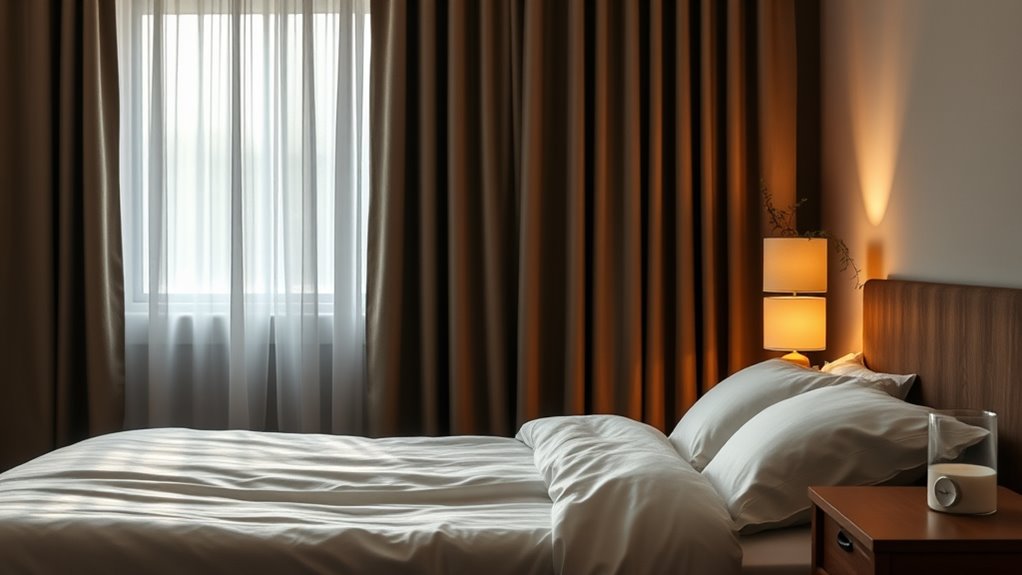
To create a more restful sleep environment, start by removing all screens from your bedroom. Set your devices to nighttime mode well before bedtime to reduce blue light exposure that disrupts sleep. Minimize distractions further by turning off notification alerts, allowing your mind to unwind without interruptions. Quality sleep is crucial for emotional regulation and stress resilience, making these steps essential for a peaceful night.
Remove Bedroom Screens
In order to improve sleep quality, consider removing screens from the bedroom to limit electronic distractions. A digital detox offers remarkable screen-free benefits as your body resets its natural sleep patterns. Exposure to blue light from screens interferes with melatonin, the hormone controlling your sleep-wake cycle, leaving you more awake than relaxed. By banishing electronic devices, you create a sanctuary that nurtures true rest and freedom from digital disturbances.
In the absence of screens, your relaxation deepens and stress ebbs away. Keeping your bedroom a screen-free zone reduces late-night technology temptations, helping you drift into sleep without the demanding presence of emails or social media. Studies show that eliminating screens can decrease depressive symptoms and anxiety, especially vital for children who are particularly susceptible to its effects.
Let your bedroom reclaim its purpose as a haven for rest and rejuvenation by richening the space with calming colors and a cooler environment.
Simply put, separating from screens an hour before bed tackles the overstimulation that bright displays cause, making it harder to fall asleep. Embrace this simple change and watch your nights transform into liberating stretches of genuine rest.
Set Up Nighttime Mode
Activate night mode and reduce screen technology’s toll on your sleep. Embracing night mode can greatly enhance your sleep hygiene by shifting screen colors to warmer tones, thereby minimizing blue light exposure. Utilize this feature on your devices to support your body’s natural sleep cycle — it can automatically activate at sundown or be manually set up. Night mode provides a perfect balance of screen visibility and circadian-friendly colors, inviting you to unwind without disrupting your internal clock.
| Feature | Impact | Tips for Use |
|---|---|---|
| Night Mode Activation | Reduces eye strain | Set to activate at sunset |
| Color Adjustment | Warms screen colors | Use red/pink shift |
| Automatic Timing | No disruption to melatonin | Schedule in settings |
| Eye Comfort | Eases light adjustment | Lower brightness before sleep |
| Device Compatibility | Widely available | Check settings on each device |
Devices under your control offer night mode to counteract blue light’s bombardment, which usually tricks your brain into alertness. While the night mode helps, you should also consciously limit screen use, especially before bedtime, to foster ultimate relaxation. Experience the freedom of technology tamed, allowing your mind to prefer restful slumber over late-night alerts. Consistent application of these techniques cultivates liberation from restless nights, empowering you to harness serene sleep habits effortlessly.
Minimize Notification Alerts
While embracing night mode helps prepare your mind for restful sleep, minimizing notification alerts further protects your sanctuary of slumber. Start by mastering notification management.
Turn off push notifications altogether to prevent your devices from lighting up or buzzing at night. Enabling “Do Not Disturb” mode is another powerful tool. It silences all notifications, saving you from distractions that disrupt your peace. By avoiding vibrations and flashing alerts, you’ll cultivate a more serene atmosphere.
To achieve true distraction reduction, consider putting your devices in airplane mode before bed, ensuring a peaceful night without interruptions. This simple change greatly reduces unwelcome disturbances.
Keep sound notifications switched off, creating a quiet oasis for sleep. For a liberated rest, remove temptation entirely by keeping electronic devices out of the bedroom. Charge them in a separate room to diminish distractions and limit device-related radiation.
Embrace the idea of a tech-free zone by adopting alternative alarm clocks. Embrace a quaint charm with a traditional alarm clock instead of your phone.
This deliberate choice not only enhances relaxation but also sets the stage for a genuine escape into tranquility. You’ll awaken refreshed, freed from the chains of constant connectivity.
Incorporate Soothing Elements
A variety of soothing elements can transform your sleep environment into a serene sanctuary. Start with aroma therapy, a powerful tool that not only lures you into a state of relaxation but also liberates your senses. Carefully consider scent selection: lavender and vanilla are popular choices, each known for their calming properties. These essential oils, when dispersed through diffusers or vaporizers, fill your space with tranquility, encouraging a peaceful rest. Scents like these have the ability to reduce stress and anxiety, key components in achieving a restful night’s sleep. Prioritizing quality sleep is vital as it enhances overall health by boosting immune system function and aiding in stress regulation. Beyond aroma, optimizing lighting is vital. Keep your room as dark as possible to support your natural circadian rhythm. Utilize blackout curtains or shades to shield against intrusive external lights. Replace electronic devices emitting harsh blue light with dim, warm-toned lighting to ease you into drowsiness.
Track and Improve Sleep Patterns
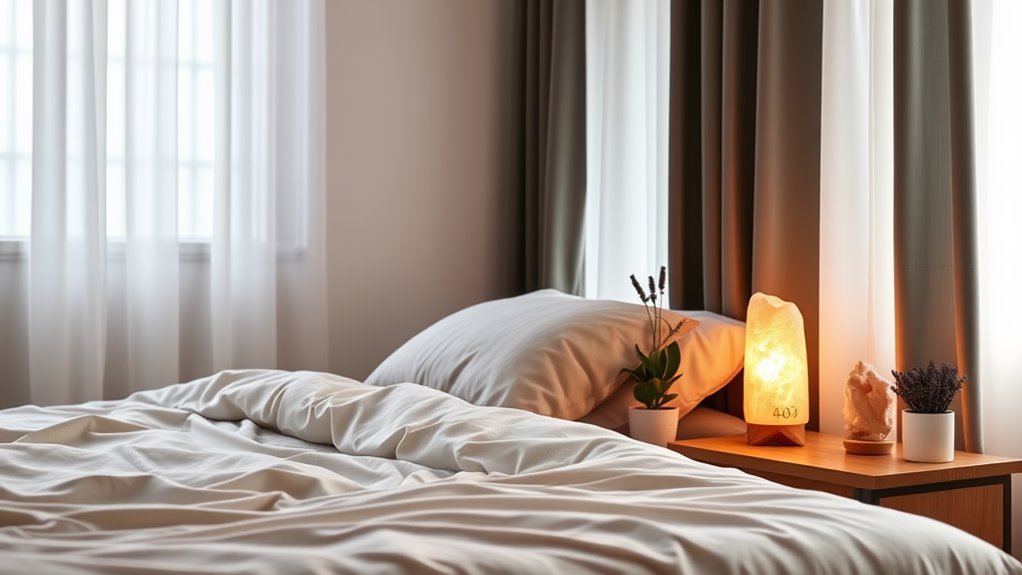
To truly enhance your sleep quality, consider a proactive approach with tracking and improving sleep patterns. Utilize sleep data from wearable devices like Apple Watch or non-wearable options such as under-mattress sensors to reveal insights about your nightly rest.
These devices measure sleep efficiency by keeping tabs on your sleep duration and phases, providing a sleep score to guide your improvements. Analyzing lifestyle factors, like caffeine intake and stress, alongside this data helps pinpoint potential sleep disruptors within your routine.
Harness these insights with personalized advice, allowing you to set meaningful sleep goals that align with your body’s natural circadian rhythms. By delving into trend analysis, you’ll spot patterns and efficiently adapt your habits over time.
Use this process as a stepping stone to true self-liberation, freeing yourself from restless nights.
- Leverage wearable and non-wearable devices for thorough sleep tracking.
- Analyze lifestyle factors to identify and eliminate sleep disruptors.
- Utilize trend analysis to tailor your sleep goals effectively.
- Use personalized advice to align your sleep with circadian rhythms.
- Regularly review sleep scores for continuous improvement.
The future of restful sleep lies in this blend of technology and self-awareness.

